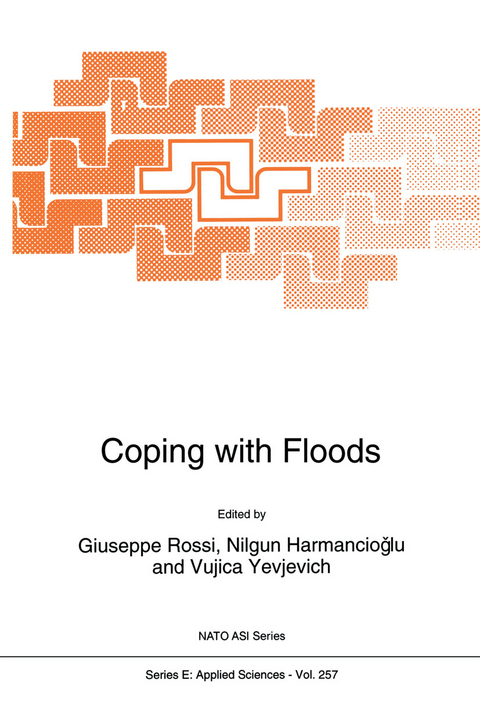
Coping with Floods
Springer (Verlag)
978-94-010-4480-6 (ISBN)
Floods are natural hazards whose effects can deeply affect the economic and environmental equilibria of a region. Quality of life of people living in areas close to rivers depends on both the risk that a flood would occur and the reliability of flood forecast, warning and control systems.
Tools for forecasting and mitigating floods have been developed through research in the recent past. Two innovations currently influence flood hazard mitigation, after many decades of lack of significant progress: they are the development of new technologies for real-time flood forecast and warning (based on weather radars and satellites) and a shift from structural to non-structural flood control measures, due to increased awareness of the importance of protecting the environment and the adverse impacts of hydraulic works on it.
This book is a review of research progress booked in the improvements of forecast capability and the control of floods. Mostly the book presents the results of recent research in hydrology, modern techniques of real-time forecast and warning, and ways of controlling floods for smaller impacts on the environment. A number of case studies of floods in different geographical areas are also presented.
Scientists and specialists working in fields of hydrology, environmental protection and hydraulic engineering will appreciate this book for its theoretical and practical content.
1. Floods and society.- 2. Historical development of flood analysis methods.- 3. Technology for coping with floods in the 21st century.- 4. Hydrometeorological data collection networks.- 5. Rainfall frequency analysis for flood design.- 6. Determination of flood characteristics by physically-based methods.- 7. Determination of flood characteristics using systematic, historical and paleoflood data.- 8. Regional flood estimation methods.- 9. Assessment of information and uncertainty related to floods.- 10. Some notes on generalized methods of flood estimation in the United Kingdom.- 11. A project for regional analysis of floods in Italy.- 12.1 Analysis of regional maximum precipitation.- 12.2 Some problems involved in using partial duration series for regional flood frequency analysis.- 12.3 Robustness analysis of regional flood frequency models: a case study.- 12.4 Stochastic simulation of streamflow with short time interval.- 12.5 Floods in arid south-east Spanish areas: a historical and environmental review.- 12.6 Flood control by decomposition of the flow regime of a river network according to its tributaries using linear dynamic model.- 13. Flood waves and flooding models.- 14. Flooding vulnerability analysis at basin-wide scale.- 15. Flood risk mapping.- 16. Floods and sediment dynamics in mountain rivers.- 17.1 Estimation of downstream hydraulic geometry exponents with emphasis on channel flow velocity.- 17.2 Flash flood modeling on Macks Creek.- 18. Early warnings and quantitative precipitation forecasting.- 19. Evolution of the national flood forecasting system in the USA.- 20. Assessment of forecast technology for flood control operation.- 21. Remote sensing for forecasting of floods.- 22. Uncertainty in flood forecasting: a French case study.- 23. Empirical Orthogonal Functions (EOF) method in determining and forecasting storm floods in the coastal zones of the sea.- 24. Assessment of the economic effects of flooding.- 25. Environmental impact of floods.- 26. Public response to flood warnings.- 27. Flood interaction with river crossings: a case study.- 28. Classification and description of flood mitigation measures.- 29. Economics of selection of flood mitigation measures.- 30. Economic evaluation and multicriterion ranking of alternative flood mitigation actions.- 31. Flood control by levees.- 32. Flood control by reservoirs.- 33. Flood control in the Danube countries.- 34. Operation of water resources systems and reservoirs for flood control.- 35. Flood control measures in the River Thames catchment.- 36. Remote sensing for control of floods.- 37. Urban flooding: the flood-planned city concept.- 38. Flood disaster relief, rehabilitation and reconstruction.- 39. Coping with floods in Setúbal: a few steps towards an integrated approach.- 40.1 Flood control in the former USSR.- 40.2 Flood retention basins in the Mediterranean urban areas.- 40.3 Flash flood in Slovenia in 1990: damage and protection.
| Reihe/Serie | NATO Science Series E ; 257 |
|---|---|
| Zusatzinfo | XIII, 776 p. |
| Verlagsort | Dordrecht |
| Sprache | englisch |
| Maße | 160 x 240 mm |
| Themenwelt | Naturwissenschaften ► Biologie ► Ökologie / Naturschutz |
| Naturwissenschaften ► Geowissenschaften ► Geologie | |
| Naturwissenschaften ► Geowissenschaften ► Hydrologie / Ozeanografie | |
| Naturwissenschaften ► Geowissenschaften ► Meteorologie / Klimatologie | |
| Technik ► Bauwesen | |
| ISBN-10 | 94-010-4480-5 / 9401044805 |
| ISBN-13 | 978-94-010-4480-6 / 9789401044806 |
| Zustand | Neuware |
| Informationen gemäß Produktsicherheitsverordnung (GPSR) | |
| Haben Sie eine Frage zum Produkt? |
aus dem Bereich


